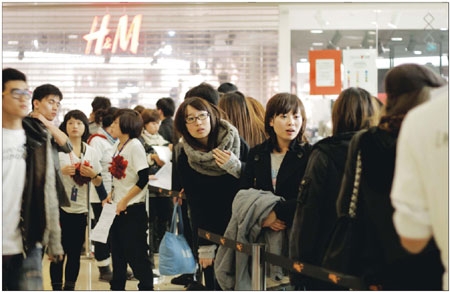Economy
Exclusive brand reaches out to mass market
Updated: 2010-12-03 13:43
By Shi Yingying (China Daily European Weekly)

Shoppers crowd in an H&M store in Hangzhou, East China's Zhejiang province, to choose their favorite Lanvin items. [Photo/For China Daily]
Exclusive brand reaches out to mass market
The queues stretched around the block and might well have been for a Rolling Stones concert. Hundreds camped out on pavements for hours to ensure they would be among the first when the doors opened. But instead of tickets to a show, they were queuing for free tickets to gain admission into established H&M stores in four large Chinese cities on Nov 23. On that day, the Swedish chain had a very good reason for restricting entry: The launch of a special line of Lanvin fashion products at mass-market prices.
H&M, with more than 2,000 stores around the world, had joined forces with the 121-year-old Parisian fashion aristocrat for a special act in haute couture.
As part of the deal, Lanvin would design and produce special lines of clothing, bearing its name and retailing at close to mass-market prices in selected H&M stores.
Two hundred H&M stores, including seven on the Chinese mainland and four in Hong Kong, retail lower-priced Lanvin products such as brightly patterned tights, dazzling costume jewelry and gowns made up of sexy mishmashes of bows, ribbon and poofy fabrics.
In Shanghai, more than 1,000 customers, some from cities in Jiangxi province in East China 600 kilometers away, flocked to the store.
Among those in line were scalpers who resold the tickets to latecomers at up to 300 yuan (about 34 euros) each.
Wei Na, from Shanghai, said hundreds of people waited with her from the night before.
"We tried to recognize faces of people standing in front and behind me to ensure no one attempted to jump the queue," said the 20-year-old, who began her wait about 16 hours before doors opened.
"Most of those people waiting with me were young women. We all brought sisters, brothers and boyfriends because there was a limit on how many items each customer could buy."
Strict rules to discourage hoarding were imposed, with each shopper allowed into the specially designated Lanvin area for 15 minutes only. Each customer was restricted to only one item of each product category.
Scores of security guards were posted inside and outside to maintain order.
The entire collection - of about 30 styles of women's wear, 15 varieties of accessories, 25 men's wear products and 10 accessories - was sold out in four hours at the two H&M outlets in Shanghai.
In Hangzhou, East China's Zhejiang province, Zhang Wang, 25, and three friends came from Beijing - 1,400 km away - to buy Lanvin goods, despite them being sold in some H&M stores in Beijing.
"We believed that we stood a better chance in Hangzhou than in Beijing," Zhang said.
And they did. Zhang and his friends were among the first customers to enter the H&M branch in Hangzhou's MixC shopping mall, in the emerging downtown area near Qiantang River.
Their total purchase, including numerous T-shirts, jackets, shoes and sunglasses, in 15 minutes amounted to about 15,000 yuan.
"That's reasonable money to spend on buying so many items of a top-name brand," Zhang said.
In Hong Kong, queues formed outside H&M's Central branch store 60 hours before the Lanvin sales. "It was like a refugee camp outside H&M," a shopper told the South China Morning Post.
"We hired someone to start lining up at 7 pm on Monday and we went to take over from them at about 5 am, five hours before opening, and it was still quite hectic."
Co-branding between designers and budget fashion is not new. Fashion consultant Jean-Jacques Picart told AFP that since the 1990s, women have been playing pick and mix between high fashion and budget clothes.
The marriage was also not the first time that H&M experimented with top designers. In 2004, H&M lifted its monthly sales by a quarter by tying up with German fashion designer Karl Lagerfeld, who has worked with Chanel and Fendi.
First-tier designers such as Stella McCartney, Comme des Garcons, Matthew Williamson and Viktor & Rolf have also hooked up with H&M.
Israeli designer Alber Elbaz, who is credited for reviving Lanvin, one of the oldest Paris fashion houses, said he was intrigued by the idea of "H&M going luxury rather than Lanvin going public".
For many consumers in China, price is the key reason for the long queues. "How many of us can afford a real Lanvin?" asked 26-year-old Zhao Guangwu.
"I can't afford a 9,000 yuan Lanvin dress, but I will pay 1,500 yuan for a Lanvin-for-H&M dress. High-end style at high-street price. Why not?"
E-paper

Ear We Go
China and the world set to embrace the merciful, peaceful year of rabbit
Preview of the coming issue
Carrefour finds the going tough in China
Maid to Order
Specials

Mysteries written in blood
Historical records and Caucasian features of locals suggest link with Roman Empire.

Winning Charm
Coastal Yantai banks on little things that matter to grow

New rules to hit property market
The State Council launched a new round of measures to rein in property prices.
